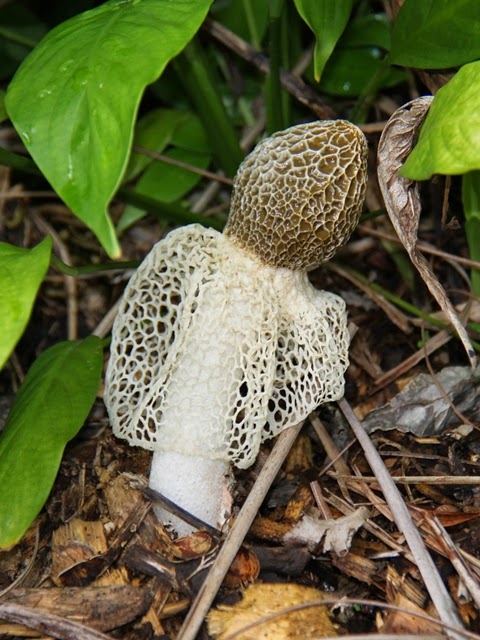Way, way back in 1976, in
my A-Level biology class at school in Singapore, I first heard of a peculiar
type of fungus, the name of which, Phallus
impudicus, says it all (Phallus,
well…; and impudicus meaning
shameless or immodest). Its common name is somewhat less explicit but just as
appropriate - the Common Stinkhorn.
A few years later, while
an undergrad at university in Canberra, I bought a book titled The Sex Life of Plants, by Alec Bristow
(Cassell Australia, 1978) for which the frontispiece (if not the dust-jacket!)
is a very suggestive drawing of Phallus impudicus
below the flower of a species from the pea family called Clitoria ternatea.
Ever since, I
have wanted to see in the wild any of the Phallus
species. Not purely for any puerile titillative reasons you understand, but because of their
remarkable structure, and because I have a general interest in fungi along with
so many other things in nature.
Well, it has
finally happened! While in Cairns last weekend, I saw two specimens of a
related species, Phallus indusiatus,
which if anything is more incredible in structure than P. impudicus. [indusiatus is from the Latin meaning 'wearing an undergarment'.] They were thrusting from the mulch around the bushes
in the immaculately manicured gardens of the motel/resort we were staying at,
just metres from the door of our unit.
.jpg) |
| Phallus indusiatus, the Bridal Veil Mushroom, is also known variously as the Veiled Lady, Long Net Stinkhorn, Crinoline Stinkhorn, Basket Stinkhorn, and Bamboo Mushroom. |
P. indusiatus is one of
around 30 species in the genus Phallus,
the stinkhorns, in the family Phallaceae. They are generally of tropical
distribution, with several species occurring in Australia. P. indusiatus is widely distributed and has been found in Africa
(Zaire, Congo, Nigeria and Uganda), South and Central America (Brazil, Guyana,
Venezuela, Tobago, Costa Rica), Mexico, Asia (Japan, southern China, Taiwan, India,
Malaysia and Indonesia), and in Australia. Most species, however, are more
restricted in range than this. http://en.wikipedia.org/wiki/Phallus_(fungus)
They are
called stinkhorns because, unlike most mushrooms that shed spores into the air
for dispersal, these produce a sticky spore mass on their conical tip which produces
a strong carrion-like odor. This attracts insects, particularly flies, which
then help disperse the mushroom’s spores.
 |
| Flies, in this case a sarcophagid fly, are attracted by the putrescent odor produced by the slimy spore mass of Phallus indusiatus. |
And for
anyone wondering – yes they are edible! And no, I didn’t try it. They are
apparently rich in protein, carbohydrates and dietary fibre, and are used in
Chinese cuisine, particularly stir-fries and chicken soup. They are now grown
commercially and are also used in Chinese medicine, containing various
bioactive compounds as well as having antioxidant and antimicrobial properties.
Wikipedia has
lots of interesting information, including on culinary aspects, folklore,
chemistry and so on, and is well worth a
read: http://en.wikipedia.org/wiki/Phallus_indusiatus
.jpg)
Thanks for aa great read
ReplyDelete